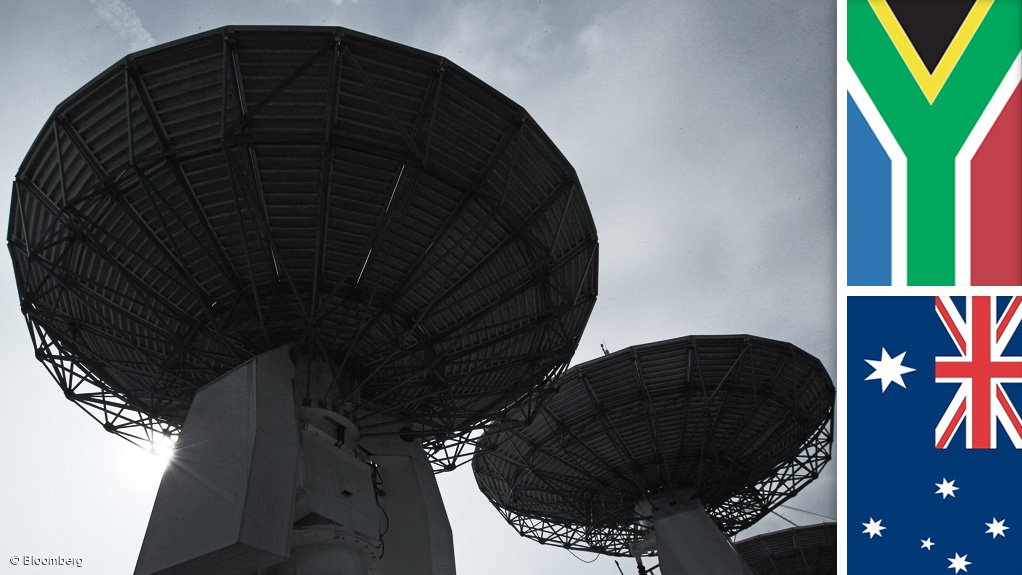Square Kilometre Array project, South Africa – update
Name of the Project
Square Kilometre Array (SKA) project.
Location
Africa and Australia.
Project Owner/s
The SKA telescope will be co-hosted by South Africa and Australia, with outstations to be established later in other countries. Outstations for the South African core element of the SKA will be in Botswana, Ghana, Kenya, Madagascar, Mauritius, Mozambique, Namibia and Zambia. The head office is being hosted by the UK.
Project Description
The SKA will provide a collecting area of one-million square metres, which demands a revolutionary break from traditional radio-telescope design.
The project will use three types of antennas (radio-wave receptors) – dishes, midfrequency aperture arrays and low-frequency aperture arrays – to provide continuous frequency coverage from 70 MHz to 10 GHz. Combining the signals from the antennas will create a telescope with a collecting area equivalent to a dish with an area of about 1 km2.
The first phase of the SKA, known as SKA1, will result in the creation of two complementary instruments, one each in South Africa and Australia.
The South African instrument, known as SKA1–Mid, will comprise about 200 dishes and operate in the 350 MHz to 14 GHz frequency range. The Australian instrument, known as SKA1–Low, will comprise more than 100 000 (perhaps as many as 130 000) dipole antennas and will operate in the 50 MHz to 350 MHz frequency range.
SKA1–Mid will include the 64 dishes of the South African precursor to the SKA, the MeerKAT radio telescope array, being built in the Karoo region. Australia’s precursor, the Australian SKA Pathfinder (better known as Askap and already in operation) will serve as surveying instrument for the SKA.
The central regions, in Australia and in South Africa, will contain cores, each 5 km in diameter – one for each antenna type. Fifty per cent of the collecting area will be within the central cores. The aperture array antennas will extend to about 200 km from the core regions. In Africa, the dishes will be positioned at distant stations that are 3 000 km from the core regions.
The construction of the SKA will be phased.
Phase 1 (SKA1) will comprise about 10% of the array and will include dishes and low-frequency aperture arrays.
The Australian SKA Pathfinder and South Africa’s Meerkat precursor dishes will be incorporated in the SKA1. The Murchison Widefield Array, located at the Australia site, is another precursor telescope to the SKA.
Phase 2 (SKA2) will extend the array with midfrequency aperture arrays and further dishes.
All the dishes for SKA2 will be located in Africa. All the low-frequency aperture arrays will be located in Australia and all the midfrequency aperture arrays will be built in Southern Africa.
The phased construction of the telescope will mean that the SKA can start operating before construction is completed.
Potential Job Creation
More than 1 000 engineers and scientists in 20 countries have been involved in designing the SKA over the past five years, with new research programmes and educational initiatives and collaborations being created in various countries to train the next generation of space scientists and engineers.
Capital Expenditure
SKA1 is expected to cost €650-million (about R8.9-billion).
Planned Start /End Date
Construction of the first phase of the SKA is expected to start in 2021.
SKA–Mid Phase 1 is expected to be operational by 2028.
Latest Developments
The Department of Forestry, Fisheries and the Environment has said amendments to the Integrated Environmental Management Plan required to manage the impacts associated with the development of the first phase of the SKA, have been published.
No further environmental approval will be required.
The Adoption of Amended Chapter 2 and Chapter 5 of the Integrated Environmental Management Plan for Phase 1 of the SKA and Amendment to the Conditions of Exclusion were published by Forestry, Fisheries and Environment Minister Barbara Creecy in the Government Gazette on March 25.
An amendment to the originally adopted plan was requested by the National Research Foundation, the organisation that is responsible for the development of the SKA.
The amendments are necessary, as the proposed construction camps will pose a risk to the optimal functioning of the Meerkat radio telescopes that are in operation.
The amendments include the acknowledgement of the declaration of portions of the SKA site as the Meerkat National Park and the increase in the land core area, as well as the development of a perimeter road along the boundary fence and a solar farm to contribute to the electricity needs of the facility.
To support the request for amendments, additional environmental assessments were undertaken and it was concluded that the activities would not impact negatively on the environment.
It was, therefore, decided to approve the amendments the original plan.
Key Contracts, Suppliers and Consultants
None stated.
Contact Details for Project Information
SKA South Africa, email enquiries@ska.ac.za.
Comments
Press Office
Announcements
What's On
Subscribe to improve your user experience...
Option 1 (equivalent of R125 a month):
Receive a weekly copy of Creamer Media's Engineering News & Mining Weekly magazine
(print copy for those in South Africa and e-magazine for those outside of South Africa)
Receive daily email newsletters
Access to full search results
Access archive of magazine back copies
Access to Projects in Progress
Access to ONE Research Report of your choice in PDF format
Option 2 (equivalent of R375 a month):
All benefits from Option 1
PLUS
Access to Creamer Media's Research Channel Africa for ALL Research Reports, in PDF format, on various industrial and mining sectors
including Electricity; Water; Energy Transition; Hydrogen; Roads, Rail and Ports; Coal; Gold; Platinum; Battery Metals; etc.
Already a subscriber?
Forgotten your password?
Receive weekly copy of Creamer Media's Engineering News & Mining Weekly magazine (print copy for those in South Africa and e-magazine for those outside of South Africa)
➕
Recieve daily email newsletters
➕
Access to full search results
➕
Access archive of magazine back copies
➕
Access to Projects in Progress
➕
Access to ONE Research Report of your choice in PDF format
RESEARCH CHANNEL AFRICA
R4500 (equivalent of R375 a month)
SUBSCRIBEAll benefits from Option 1
➕
Access to Creamer Media's Research Channel Africa for ALL Research Reports on various industrial and mining sectors, in PDF format, including on:
Electricity
➕
Water
➕
Energy Transition
➕
Hydrogen
➕
Roads, Rail and Ports
➕
Coal
➕
Gold
➕
Platinum
➕
Battery Metals
➕
etc.
Receive all benefits from Option 1 or Option 2 delivered to numerous people at your company
➕
Multiple User names and Passwords for simultaneous log-ins
➕
Intranet integration access to all in your organisation





















